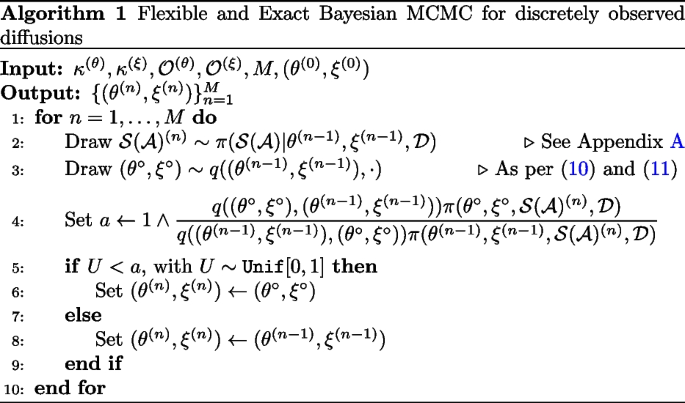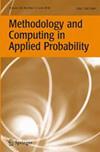基于样条的扩散过程柔性贝叶斯推理
IF 1
4区 数学
Q3 STATISTICS & PROBABILITY
Methodology and Computing in Applied Probability
Pub Date : 2023-10-27
DOI:10.1007/s11009-023-10056-9
引用次数: 0
摘要
摘要介绍了一种灵活的方法,可以同时推断离散观测标量扩散的漂移函数和波动函数。我们引入样条基来表示这些函数,并开发了一种马尔可夫链蒙特卡罗算法来在后验地推断这些函数在样条基中的系数。一个关键的创新是我们使用样条基来建模漂移和波动函数的转换版本,而不是函数本身。该算法的输出是不受任何特定参数族约束的可信漂移和波动函数的后验样本。这种方法的灵活性为从业者提供了一个强大的调查工具,允许他们假设各种参数模型,以更好地捕获他们感兴趣的过程的潜在动态。我们通过将其应用于来自金融、古气候学和天体物理学的具有挑战性的数据集来说明我们方法的多功能性。鉴于文献中对这些例子广泛采用的参数扩散模型,我们的一些结果令人惊讶,因为它们对这些模型的某些方面提出了质疑。本文章由计算机程序翻译,如有差异,请以英文原文为准。

Flexible Bayesian Inference for Diffusion Processesusing Splines
Abstract We introduce a flexible method to simultaneously infer both the drift and volatility functions of a discretely observed scalar diffusion. We introduce spline bases to represent these functions and develop a Markov chain Monte Carlo algorithm to infer, a posteriori, the coefficients of these functions in the spline basis. A key innovation is that we use spline bases to model transformed versions of the drift and volatility functions rather than the functions themselves. The output of the algorithm is a posterior sample of plausible drift and volatility functions that are not constrained to any particular parametric family. The flexibility of this approach provides practitioners a powerful investigative tool, allowing them to posit a variety of parametric models to better capture the underlying dynamics of their processes of interest. We illustrate the versatility of our method by applying it to challenging datasets from finance, paleoclimatology, and astrophysics. In view of the parametric diffusion models widely employed in the literature for those examples, some of our results are surprising since they call into question some aspects of these models.
求助全文
通过发布文献求助,成功后即可免费获取论文全文。
去求助
来源期刊
CiteScore
1.70
自引率
0.00%
发文量
58
审稿时长
6-12 weeks
期刊介绍:
Methodology and Computing in Applied Probability will publish high quality research and review articles in the areas of applied probability that emphasize methodology and computing. Of special interest are articles in important areas of applications that include detailed case studies. Applied probability is a broad research area that is of interest to many scientists in diverse disciplines including: anthropology, biology, communication theory, economics, epidemiology, finance, linguistics, meteorology, operations research, psychology, quality control, reliability theory, sociology and statistics.
The following alphabetical listing of topics of interest to the journal is not intended to be exclusive but to demonstrate the editorial policy of attracting papers which represent a broad range of interests:
-Algorithms-
Approximations-
Asymptotic Approximations & Expansions-
Combinatorial & Geometric Probability-
Communication Networks-
Extreme Value Theory-
Finance-
Image Analysis-
Inequalities-
Information Theory-
Mathematical Physics-
Molecular Biology-
Monte Carlo Methods-
Order Statistics-
Queuing Theory-
Reliability Theory-
Stochastic Processes

 求助内容:
求助内容: 应助结果提醒方式:
应助结果提醒方式:


